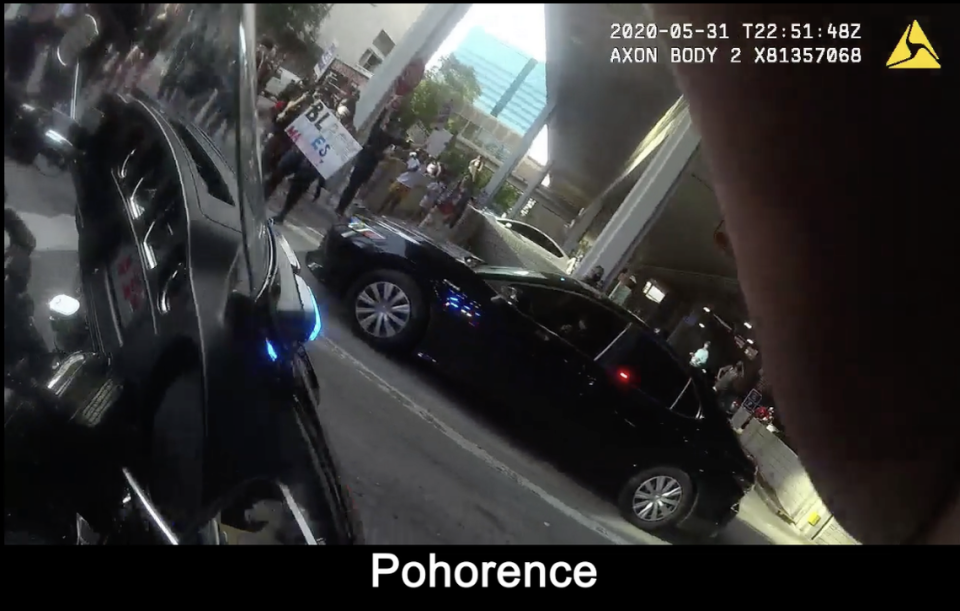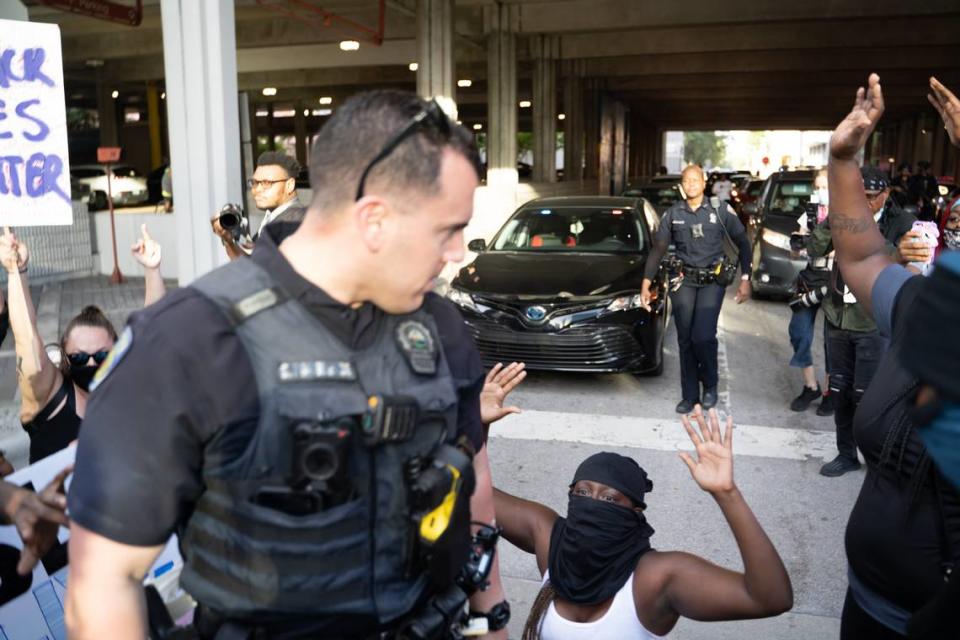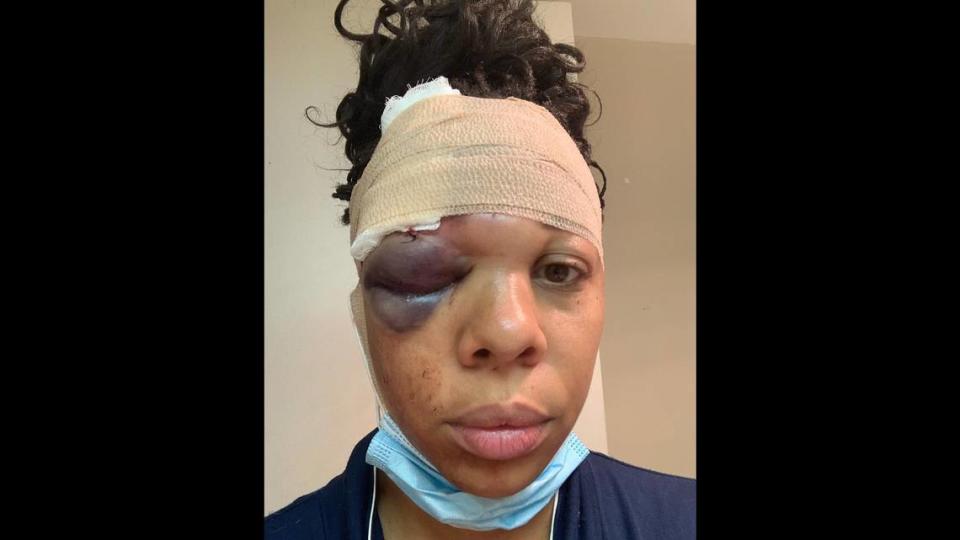A Fort Lauderdale cop reported an attack by BLM protesters. Now, the story’s changing
It’s been nearly four years since police shot tear gas and rubber bullets at protesters as they left a previously peaceful rally held in downtown Fort Lauderdale in the wake of the killing of George Floyd, fracturing the eye socket of LaToya Ratlieff.
Now, new evidence in a civil rights lawsuit filed by Ratlieff appears to undermine the department’s official justification for using chemical agents and so-called “less lethal” munitions against protesters that day.
Although there had been no violent incidents all afternoon, police said their heavy-handed tactics that evening were a response to an officer “screaming for help” over the radio as protesters attacked her unmarked police car, pounding on windows and jumping on the vehicle.
During a deposition taken under oath, the officer who made the initial distress call admitted she never actually saw anyone damaging her vehicle or jumping on the trunk as described in her incident report. And a forensic analysis of synchronized video and audio from the scene shows no evidence that protesters were surrounding the vehicle, as the officer reported as she radioed for back up.
The analysis, commissioned by Ratlieff’s attorneys and submitted as evidence, confirmed the findings of a Miami Herald investigation based on publicly available images at the time: the hours of violence between police and protesters erupted after an officer pushed a kneeling protester, prompting an angry response from the crowd. Video evidence shows police arriving to the scene following the distress call then began to deploy tear gas and hard-packed projectiles without warning.
The new evidence bolsters Ratlieff’s claim that police initiated the confrontation and escalated the situation by unlawfully deploying tear gas and other projectile weapons to clear a crowd of peaceful protesters without warning. The case also opens the door for other protesters present at the scene to file their own civil rights lawsuits.
“We believe that anyone who was tear gassed, shot by projectiles, or otherwise forced to leave the area because of this use of force had their civil rights violated,” said Michael Davis, the attorney for Kuehne Davis law who represents Ratlieff.
Ratlieff called the evidence uncovered in her case “incredible.” She encouraged other protesters to file similar lawsuits, saying the “time to pursue justice is now.”
“Anyone who was tear gassed or shot at by Fort Lauderdale Police that day should take action immediately,” Ratlieff said. “The only way to achieve change and accountability is through the courts. Fort Lauderdale has made clear they won’t change their ways voluntarily.”
Both the city of Fort Lauderdale and the police department declined to comment on active litigation.
The deadline for other protesters to file a their own lawsuits is May 31, according to applicable case law.
The officer’s story
A march through downtown Fort Lauderdale on May 31, 2020 had been peaceful all afternoon. Organizers picked up trash and de-escalated the occasional tensions that arose between police and protesters. Trouble began after the official protest ended and the crowd began to disperse.
A small group of protesters leaving the rally stopped in an intersection a few blocks away from the main staging area. There, they held up signs and chanted in front of an officer on a motorcycle and another in an unmarked police vehicle.
That’s when court records show officer Stylianee Hayes called for backup, saying — not screaming — that a group of protesters were “jumping on her car,” and that she was “completely surrounded.”
“Send me units,” she said.

In a report filed the next day, Hayes, who normally worked as a code enforcement detective, said she radioed for help because she “was trapped in a hostile crowd of subjects intending to cause me harm.” She was so worried about her life being in “imminent danger” from a “hostile and agitated” group of protesters, she reported she was “not able to activate” her body-worn camera.
“Unknown subjects were pounding on vehicle, the windows, and subjects even began to jump on the trunk of my car,” Hayes wrote in the June 1, 2020 report documenting damage to the 2019 Toyota Camry she was driving. She took a photo of a footprint on the trunk of the car, which she said was evidence of the attack. Her report also noted damage to the trunk and passenger side door.
But during a deposition in Ratlieff’s case, Hayes admitted she never actually saw anyone touching her vehicle as she told dispatch “they’re jumping on my car.” But, she said, she still believed it to be true.
“I was looking forward,” she said, when asked why she didn’t see a person if they were jumping on the trunk. “I didn’t look in my rear-view mirror,” she added when prompted.
“My car was moving, like feeling like they were jumping on my car,” Hayes clarified.
Aside from the movement, she said she had no other evidence of any physical attack on her vehicle other than the footprint on the trunk, which she said she discovered later that night but did not document until the following morning. Video submitted as evidence shows no one close to the vehicle at the time of her distress call, nor was the vehicle surrounded by protesters as she suggested.
“Do you think that you maybe said ‘they’re jumping on my car’ because you were scared at the time?” the interviewer asked.
Hayes denied it, saying “I mean, I was scared at the time, but no.”
Initiating violence
Officer Steven Pohorence was already on the scene when Hayes first made her distress call, according to videos professionally synced up with the dispatch audio and entered into evidence.
The synched video shows Pohorence had just switched on his body-worn camera as Hayes reported protesters were “starting to surround my car.” He walked past the vehicle toward a group of protesters.
Pohorence’s body-worn camera captured a full profile of Hayes’ vehicle as she radioed that protesters were jumping on the trunk. No one was touching the car. The closest protester appeared to be feet away from the front of the car at the time, and no one was on any of the other sides.
“Back up. Back up, ” Pohorence shouted as he moved into the middle of the group of protesters in the street and Hayes exited her vehicle.
Protesters responded by putting their hands up and kneeling in the street. Pohorence then shoved one young woman in the back of the head before hastily retreating back into the nearby parking garage where he was berated by Officer Krystle Smith.
“Don’t push her! You agitated her!” Smith can be heard yelling angrily at Pohorence as she clenched her hands and pointed him away from the crowd. A handful of people responded by pelting Pohorence and the other officers with plastic water bottles that were handed out at the end of the rally. Pohorence was suspended over the incident. He was later charged with battery but was acquitted by a jury who found he acted lawfully to help a colleague. Pohorence is back on active duty, according to a spokesperson for the department.

More protesters ran to join the group incensed by Pohorence’s actions, including Ratlieff, who came across the scene as she was walking to her car. While the dispatcher described an escalating situation and officers flooded the area, video shows protesters had gone back to kneeling in the streets and raising their fists — and in a few cases, their middle fingers — in protest.
When the S.W.A.T. team arrived, officers deployed tear gas at the group without warning. At that point, several protesters began chucking the smoking canisters back at the line of officers who were wearing protective equipment and carrying shields.
Officers armed with foam-batons — hard-packed projectiles shot from rifle-barreled launchers — were instructed to target anyone throwing the canisters in order to ensure the chemical stayed in place and was effective in dispersing the crowd, according to one deposition.
Body-worn camera footage first reported by the Herald shows some officers reveling in the fight, as they laughed and joked about shooting the protesters with the projectiles launched at nearly 300 feet-per-second. “Did you see me f**k up those motherf****rs?” one of the officers said to another who laughed.
Still, protesters including Ratlieff — who never threw anything — made efforts to restore calm by kneeling in the streets and asking officers to stop shooting. But just after 7 p.m. following another round of tear gas that sent the protesters scattering, detective Eliezer Ramos shot Ratlieff with a projectile as she stumbled away, choking from the chemicals, court records confirmed.
“She’s bleeding,” someone can be heard yelling in the videos. No officers are seen moving to assist Ratlieff, who was taken to the hospital by other protesters.

During an internal investigation, Ramos said he was aiming for a protester behind Ratlieff who had just hurled a teargas canister. Ramos told investigators he had a clear and safe shot when he fired. But the forensic analysis submitted to evidence showed Ratlieff was almost directly in front of the unidentified protester when Ramos took the potentially lethal shot through a cloud of tear gas.
Ramos was cleared of wrongdoing following the internal investigation, during which the lead investigator resigned after telling Ratlieff that Ramos was a “good guy.” When she sat for an interview, Ratlieff said she was inappropriately “interrogated.”
Police and city officials initially accused Ratlieff of violent actions. But the department quickly walked back their accusations, following a series of stories by the Herald that showed Ratlieff was peacefully protesting and shot while walking away from the line of officers.
The police chief who had initially tried to blame Ratlieff was removed from his post. Ratlieff testified before a congressional committee on excessive use of force against peaceful protesters.
But after two years and scant reforms, Ratlieff filed a federal civil rights lawsuit against the City of Fort Lauderdale and its police department. The case is pending after both sides filed motions for summary judgment.

